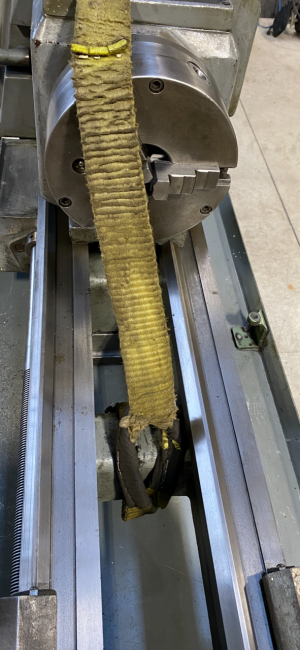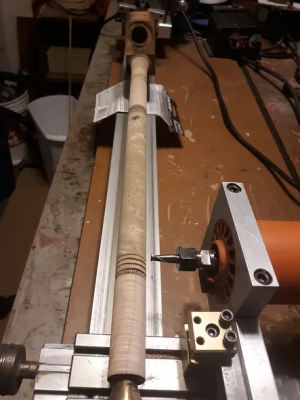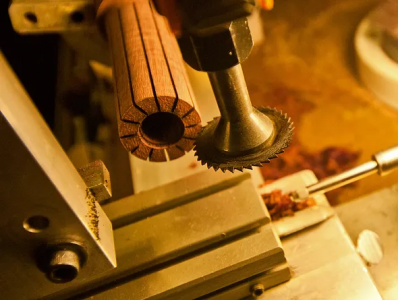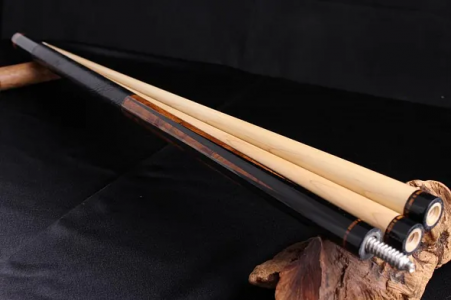- Joined
- Dec 24, 2020
- Messages
- 1,058
There are a lot of things that really need to be addressed just in case. If you know any of this, maybe it will help someone else later.
I suspect you may be light on the weight. I looked at my Logan catalog and the 10" models with cabinets start at 760lbs. Only the bench version and floor model (just feet, no cabinets) weigh under 600lbs.
For starters, with any size lathe, most of the weight is well above center. Lifting them from below (like forks under the bed or chip tray) is generally risky. If you must do that, strap the lathe to the forks and ideally to the forklift frame as well so there is no way it can slide off (have seen this happen). If you can lift it using a strap around the center webbing of the bed, even better. You'll often have to move the carriage back and forth a bit, and sometimes switch to a different cross brace, but you can usually get them balanced pretty nicely that way. With the strap around the web and run back through itself the lathe can swing and rotate, but can't fall off. If you use the strap like a hammock under the web the entire machine can pivot and still wind up hitting something. Once you have it balanced take a minute to tighten the carriage lock so it doesn't move while you're lifting/loading/unloading. I had a recent loading incident with a lathe that caused the carriage to slide into the headstock and it ruined a $200 pinion.....wouldn't have happened if I had locked the carriage (long story).
That covers lifting it on/off a trailer. How to secure it to a trailer is another story. Not to point fingers, but more often than not when I see pictures posted here of lathes on trailers, they aren't really secured properly. The most common is a strap around the headstock to one end of the trailer and a strap around the tailstock end to the other end of the trailer. That can largely keep a lathe from moving forward and backward, but doesn't do nearly as much to keep them from moving sideways, or even worse, rolling over. Ideally run two straps around the headstock end and two straps around the tailstock end. Secure one to each corner of the trailer. With four points it's locked in. That way there literally isn't any direction it can move...If it wants to move forward the back two straps hold it. If it wants to move left the right two straps hold it....etc. I have seen people use two straps going to the back of the trailer, and only one to the front, but that's not ideal. In that case they're probably thinking the biggest problem will be breaking, which it is, but with just one strap around the front it can move left/right as vibration and bumps happen (and they will). Suddenly the front has moved a couple of inches left or right and what happens? One of the back straps is now loose!
If the lathe happens to have feet that are open on the bottom like the South Bends and Sheldons with the hoop style tubular frames it would be great to run a chain across each one as well...probably overkill, but it won't hurt.
Assuming you get the lathe home and unloaded, moving it is a whole different ball of wax. Since you're going to disassemble yours quite a bit it's not as challenging, but there are some things that still apply.
If the lathe is going to be on anything with wheels...skates, dollies, etc, it absolutely has to be secured so it can't slide off. Even a ratchet strap will work. Time and again we see damaged/ruined lathes because they were being moved on some sort of wheeled device and weren't secured to them. I'm guilty of this...killed my first lathe this way. Hit a pebble, crack in the floor or your strong buddy pushes just a bit too hard from the side and the lathe slides on the dolly/skate and it's gone. Along with that topic....broom/vacuum the path before you start and ideally have a spotter who can see what you can't. They can warn you about cracks, spot any movement of the lathe on the skate/dolly/etc.
I'd go so far to say that even if you move just the bed and headstock on something like an appliance dolly or hand truck, strap it to the dolly so it can't move. You don't want to be pulling the dolly with one hand while holding the lathe with the other.
If you look at the picture of your Logan, just think that below the bed rails the only heavy thing is the motor. Assume yours weighs what the catalog says...760lbs. Probably 500lbs is above the chip tray and only 260lbs is below it...massively top heavy. One inch of lean and it's going over, no question, and it will happen in the blink of an eye.
If you have to push it's best to do it from down low, or as low as possible. A pinch bar/pry bar between the base and the floor is a safe way to go about it. If it doesn't want to move, stop and figure it out. If at all possible, don't try this if time is short...set aside an entire afternoon or a whole day.
We don't read about dropped milling machines too often because even though a Bridgeport weighs 2,000lbs plus (newer versions anyway), probably 1,500lbs of that is in the bottom half so they don't tip over easily.
I'm sure others will add all sorts of stuff I missed. Good luck!
I suspect you may be light on the weight. I looked at my Logan catalog and the 10" models with cabinets start at 760lbs. Only the bench version and floor model (just feet, no cabinets) weigh under 600lbs.
For starters, with any size lathe, most of the weight is well above center. Lifting them from below (like forks under the bed or chip tray) is generally risky. If you must do that, strap the lathe to the forks and ideally to the forklift frame as well so there is no way it can slide off (have seen this happen). If you can lift it using a strap around the center webbing of the bed, even better. You'll often have to move the carriage back and forth a bit, and sometimes switch to a different cross brace, but you can usually get them balanced pretty nicely that way. With the strap around the web and run back through itself the lathe can swing and rotate, but can't fall off. If you use the strap like a hammock under the web the entire machine can pivot and still wind up hitting something. Once you have it balanced take a minute to tighten the carriage lock so it doesn't move while you're lifting/loading/unloading. I had a recent loading incident with a lathe that caused the carriage to slide into the headstock and it ruined a $200 pinion.....wouldn't have happened if I had locked the carriage (long story).
That covers lifting it on/off a trailer. How to secure it to a trailer is another story. Not to point fingers, but more often than not when I see pictures posted here of lathes on trailers, they aren't really secured properly. The most common is a strap around the headstock to one end of the trailer and a strap around the tailstock end to the other end of the trailer. That can largely keep a lathe from moving forward and backward, but doesn't do nearly as much to keep them from moving sideways, or even worse, rolling over. Ideally run two straps around the headstock end and two straps around the tailstock end. Secure one to each corner of the trailer. With four points it's locked in. That way there literally isn't any direction it can move...If it wants to move forward the back two straps hold it. If it wants to move left the right two straps hold it....etc. I have seen people use two straps going to the back of the trailer, and only one to the front, but that's not ideal. In that case they're probably thinking the biggest problem will be breaking, which it is, but with just one strap around the front it can move left/right as vibration and bumps happen (and they will). Suddenly the front has moved a couple of inches left or right and what happens? One of the back straps is now loose!
If the lathe happens to have feet that are open on the bottom like the South Bends and Sheldons with the hoop style tubular frames it would be great to run a chain across each one as well...probably overkill, but it won't hurt.
Assuming you get the lathe home and unloaded, moving it is a whole different ball of wax. Since you're going to disassemble yours quite a bit it's not as challenging, but there are some things that still apply.
If the lathe is going to be on anything with wheels...skates, dollies, etc, it absolutely has to be secured so it can't slide off. Even a ratchet strap will work. Time and again we see damaged/ruined lathes because they were being moved on some sort of wheeled device and weren't secured to them. I'm guilty of this...killed my first lathe this way. Hit a pebble, crack in the floor or your strong buddy pushes just a bit too hard from the side and the lathe slides on the dolly/skate and it's gone. Along with that topic....broom/vacuum the path before you start and ideally have a spotter who can see what you can't. They can warn you about cracks, spot any movement of the lathe on the skate/dolly/etc.
I'd go so far to say that even if you move just the bed and headstock on something like an appliance dolly or hand truck, strap it to the dolly so it can't move. You don't want to be pulling the dolly with one hand while holding the lathe with the other.
If you look at the picture of your Logan, just think that below the bed rails the only heavy thing is the motor. Assume yours weighs what the catalog says...760lbs. Probably 500lbs is above the chip tray and only 260lbs is below it...massively top heavy. One inch of lean and it's going over, no question, and it will happen in the blink of an eye.
If you have to push it's best to do it from down low, or as low as possible. A pinch bar/pry bar between the base and the floor is a safe way to go about it. If it doesn't want to move, stop and figure it out. If at all possible, don't try this if time is short...set aside an entire afternoon or a whole day.
We don't read about dropped milling machines too often because even though a Bridgeport weighs 2,000lbs plus (newer versions anyway), probably 1,500lbs of that is in the bottom half so they don't tip over easily.
I'm sure others will add all sorts of stuff I missed. Good luck!






